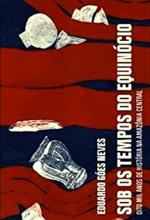Human action in time — Review by Fábio Alves dos Santos (UFS) for the book “Under the times of the equinox: eight thousand years of Central Amazonian history”, by Eduardo Góes Neves

Abstract: Under the times of the equinox: eight thousand years of Central Amazonian history”, is the most recent work by Eduardo Góes Neves. In the text, the historian, archaeologist and anthropologist tells the story of the occupation of the central Amazon over eight thousand years, covering the period of refuge between indigenous people and Europeans.
Keywords: Archeology of Central Amazon, Forest, Organic waste.
The result of 15 years of scientific work, the book entitled Under the times of the equinox: eight thousand years of the history of the Central Amazon”, was written by Eduardo Góes Neves. The author presents the craft of archeology, its methods, parameters, monitoring and the revealing results of recent research, which prove the occupation of the central Amazon, at the meeting of the Negro and Solimões rivers, which goes against the common sense that the region would always have been uninhabited. It is also the author’s objective to suggest that the forest itself would have human beings as one of its main agents, producing organic waste, managing species and plantations.
 As is evident, the author is far from being a neophyte in the field of Archaeology. In addition to his long tenure as a researcher, the professor at the Museum of Archeology and Ethnology (MAE-USP) has already supervised dozens of Dissertations and Theses, coordinated the Research Group “Historical Ecology of the Neotropics”, chaired the Brazilian Society of Archeology and is active in research on the international scene. The recently published book consumes his work in the Central Amazon Project (PAC).
As is evident, the author is far from being a neophyte in the field of Archaeology. In addition to his long tenure as a researcher, the professor at the Museum of Archeology and Ethnology (MAE-USP) has already supervised dozens of Dissertations and Theses, coordinated the Research Group “Historical Ecology of the Neotropics”, chaired the Brazilian Society of Archeology and is active in research on the international scene. The recently published book consumes his work in the Central Amazon Project (PAC).
The book is organized into five chapters, plus an introduction and conclusion. In the first two, the author explores the environment in the area of confluence of the Negro and Solimões rivers, the identification of the sites and the work carried out there, the criteria for data classification, as evidence of human heritage in the Pleistocene-Holocene transition. This last aspect focuses on the data collected at the Dona Stella site, where the oldest available evidence is found. Here the author points out that the finds, bifacial arrowheads, stand out because they date from the Early Holocene. Explores social and political changes at the beginning of the first millennium of the Common Era.
In the next two, the work addresses the issue of ceramics, from the Açutuba phase and the Pocó-Açutuba tradition and its disappearance, which are informative elements of the technological refinement of the peoples that inhabit the Central Amazon. The mounds of earth and the so-called “terras pretas”, a strong indication of the movement, albeit temporary, of settlements that are at least semi-sedentary, are also exploratory elements to understand the intellectual dynamics.
Finally, the last chapter explores, from the overlapping of pre-polychrome and polychrome ceramics, the demographic movements of the different peoples who occupied the region. It should be noted that the presence of polychrome features, of a more sophisticated nature, indicates a social dynamic that allows people to allocate more time to this type of activity. The examination of the demographic flows along the analyzed land also identified the remnants of defensive structures around the settlements, which indicates conflicts over the occupation of the territory.
The text establishes a script that begins by situating the reader with the researcher’s professional trajectory, goes through a justification of the conceptual and methodological choices, presents the localized evidence that made the capture possible, and ends with a defense of an Ancient History of indigenous peoples. As you can see, although it is an Archeology text, the dialogue with History is a central axis of the construction. The author himself identifies himself as a practitioner of the domain of a Historical Archeology. It is significant that he studied History in the 1980s before leaving for the USA where he studied for a Master’s and Doctorate in Anthropology.
This transit through different matrices of the so-called Human (or Social) Sciences is one of the factors that explains the fluidity of the text and its degree of comprehensive reach even by those who have no training in Archaeology. The work has a narrative flow that does not become boring due to the common exaggeration of the dialect typical of different fields. On the other hand, an aspect of the relationship with History can be seen as one of the passengers of the text. In seeking to justify the distinction between historical and archaeological knowledge, from an ontological point of view, Neves states that in History written documents are the primordial source, although not the only one. Well, for quite some time now, the myth of the written document as the primeval source of historiography has been overcoming by leaps and bounds. A much more solid justification for the difference between the areas is presented later on, when this topic is no longer being discussed, which refer to the methods and concepts characteristic of Archeology. In this case, it is possible to perceive the distinctions much more clearly.
The work immediately presents the challenges of Archeology in a terrain such as the Amazon rainforest. Throughout the reading we will become familiar with terms such as lowlands of South America. A layman can immediately relate the name to the geographical extension to the south of the continent, but, in fact, it is the territory that is east of the Andes Mountains and that everyone understands as the Incas (not to be confused with the Mayans and Aztecs who inhabit another part of the continent).
Neves presents us with a very different context, the Central Amazon. He immediately struggled with how challenging it is to identify archaeological sites that are often located in dense forest or areas prone to regular flooding.
These terrain particularities are the basis for justifying the use of “hybrid” methodologies typical of archaeological research, but commonly used separately. Here is a great lesson that the author presents: more than following the rigidity of method, it is necessary to record the procedures adopted and their reasons. It is the realization of this movement that made it possible for the author and his group to investigate the human presence in Central Amazonia between the 4th century BC and the 16th century CE. It is also what made it possible to contradict classical theses of Anthropology about the occupation of tropical forests by our species, establishing a presence for the investigated space that dates back 12 thousand years.
Ceramic traditions and phases, presence of terra pretas, mounds and cemeteries, remnants of settlement defense structures. This is, finally, the route expressed in Neves’ text to lead us to an understanding of the diversity of ways of living of the peoples who have occupied the Amazon for millennia. Add to this strategy the execution of a sober, simple, clear editorial project, with brief texts, titles of realistic complements, abundantly illustrated by maps, pictures and photographs that narrate processes, images that take up the entire width of the stain, and we will have a great contribution, mainly, to professionals in Archaeology, Anthropology, History, Geography and Sociology.
The book explores a presence that has left traces that are often difficult to locate (as in the case of ceramic remains), and at other times that go unnoticed when outside the analytical gaze of the researcher willing to diversify his ways of observation (as is the case of the plant composition of the forest). Thus, fulfilling its central objectives of “reconstituting” the history of the indigenous occupation of the central Amazon on a millennial scale, extrapolar methods and hypotheses for understanding other histories and other contexts in South America. It should, therefore, be read by professionals in the areas mentioned above, as well as by popularizers of the subject, especially in elementary and high school teaching.
Summary of Sob os tempos do equinócio – Oito mil anos de história na Amazônia central
- Introdução
- O fazer arqueológico: materiais, métodos, práticas e conceitos
- O começo: as primeiras evidências da presença indígena
- Paisagens em construção: a natureza transformada
- Montículos, terras pretas e cemitérios
- Guerra e paz na virada do milênio
- Conclusão — Por uma história antiga dos povos indígenas
- Agradecimentos
- Referências bibliográficas
- Índice de mapas e figuras
- Sobre o autor
To broaden your literature review
- Consult book reviews on
- Arqueologia| Arqueologia da Amazônia Arqueologia da Paisagem | Arqueologia Funerária | Arqueologia Pré-histórica Arqueologia sul-americana
- Amazônia| Amazônia Brasileira | Amazônia Colombiana | Amazônidas
- Cultura da Amazônia
- História da Amazônia
- História dos povos indígenas| História indígena
- Indígenas
- Ocupação da Amazônia
- Pan-amazônia
- Povos indígenas
- Consult dossiers of articles on
- Arqueologia| Arqueologia Brasileira | Arqueologia da Paisagem | Arqueologia Pública
- Amazônia| Amazônia Global | Amazônia Legal | Amazônias
- Etno-história indígena
- Filosofias Indígenas Ameríndias
- História Indígena
- Historiografia indígena
About the reviewer

Fábio Alves dos Santos holds a PhD in Education and is a professor at the Department of Education (DED) and at the Professional Master’s Degree in History Teaching (ProfHistória) at the Universidade Federal de Sergipe (UFS). Among other works, he published Das cadeiras isoladas ao Atheneu Sergipense: elite letrada e ofício docente em Sergipe no século XIX e Aprendizagem Histórica: espaços, suportes e experiências. Currículo Lattes: http://lattes.cnpq.br/7318880050555416; Orcid: https://orcid.org/0000-0001-8969-3031. E-mail: fabioalves@academico.ufs.br.
To cite this review
NEVES, Eduardo Góes. Sob os tempos do equinócio: oito mil anos de história na Amazônia central. São Paulo: Editora UBU; Editora da USP, 2022. 224 p. Review by: SANTOS, Fábio Alves. Human action in time. Crítica Historiográfica . Natal, v.3, n.11, May/June, 2023. Available in <https://www.criticahistoriografica.com.br/en/human-action-in-time-review-by-fabio-alves-dos-santos-ufs-for-the-book-under-the-times-of-the-equinox-eight-thousand-years-of-central-amazonian-history-by-eduardo-goes/>. DOI:
© – The authors who publish in Crítica Historiográfica agree to the distribution, remixing, adaptation and creation of their texts, even for commercial purposes, provided that due credit is guaranteed for the original creations. (CC BY-SA).








